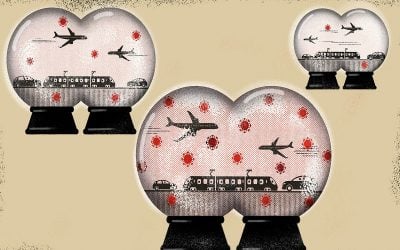“Travel Bubbles” Would be Best if They Were Based on Regional Trade Blocs

Every regional trade bloc could put this strategy into practice so that the final phase of this plan could see them all eventually opening up with one another. Be it the East African Community (EAC) or Economic Community Of West African States (ECOWAS) in Africa, the EU, the Russian-led Eurasian Economic Union, South America’s Mercosur, South Asia’s SAARC, or North America’s USMCA (formerly NAFTA), among others, they can all come together within the next 1-2 years in order to return the world to its pre-COVID-19 status quo.
Australia and New Zealand are in discussions about creating what’s been described as the so-called “Trans-Tasman travel bubble” between their two nations in a bid to restart international tourism. This concept refers to a space within which each member’s citizens can travel freely considering their countries’ similar successes in containing COVID-19. There’s already talk about expanding this proposed “travel bubble” to include China, the Republic of Korea, Singapore, and the South Pacific island nations.
This idea is a promising one since it could help revive the tourism industry, but it would be made all the better if the “travel bubbles” were based on regional trade blocs. The free movement of people perfectly pairs with the free movement of goods, and restarting regional trade in parallel with reviving the regional tourism industry would be beneficial for every country involved. Should the earlier described “trade bubble” enter into effect, then it would broadly align with the contours of the Regional Comprehensive Economic Partnership (RCEP).
The Asia-Pacific region is regarded as one of the economic engines of the world, hence the importance of RCEP, which aims to integrate the ASEAN countries, Australia, China, Japan, New Zealand, and the Republic of Korea into a mega trade bloc. The deal was supposed to have been finalized sometime this year, but the COVID-19 pandemic will might delay it until sometime in 2021. Nevertheless, these countries could build upon their economic integration progress by pioneering a regional “travel bubble” throughout the course of this year.
This part of the world has thus far thankfully escaped the ravages of the COVID-19 pandemic that Europe and North America are presently suffering, thus placing it ahead of everyone else when it comes to recovering from this crisis. Accordingly, it follows that the gradual reopening of their borders with one another would be greatly aided if trade and travel were revived in parallel. Such a strategy would accelerate the restoration of globalization and thus help everything return to as normal as possible under these changed circumstances.
Every other regional trade bloc could put this strategy into practice as well so that the final phase of this plan could see them all eventually opening up with one another. Be it the East African Community (EAC) or Economic Community Of West African States (ECOWAS) in Africa, the EU, the Russian-led Eurasian Economic Union, South America’s Mercosur, South Asia’s SAARC, or North America’s USMCA (formerly NAFTA), among others, they can all come together within the next 1-2 years in order to return the world to its pre-COVID-19 status quo.
The sudden shock that the pandemic gave to the globalized world order that practically everyone took for granted means that it cannot be restored right away. Instead, a gradual, phased approach is necessary, ergo the reason behind beginning this process at the regional level and focusing on the world’s extant trade blocs that cover nearly the entirety of the planet. Step by step and little by little, the coordinated reopening of these regional trade blocs in terms of the free movement of people and goods will lay the basis for everything else.
The Asia-Pacific region, and specifically its proposed RCEP, is in the best position to spearhead this plan considering its low level of infection and comparative quickness in surviving this crisis. The countries that make up this part of the world could therefore blaze the path that the others would follow, which would also significantly symbolize the rise of what many observers have predicted will be the Asian Century. Starting from Australia “down under” and all the way up to China, this entire strategic space might be the first to reopen.
However this process plays out, one thing is for certain, and it’s that the free movement of people will inevitably have to resume in order to fully revive the globalized world order that was abruptly frozen by COVID-19. That’s why the “travel bubble” proposal is so important because it presents a promising way to bring this about, one which could begin with tourism and then gradually expand to include the free movement of labor up to its pre-crisis levels. If the RCEP states seize this unique opportunity, then they could help the whole world.
*
Note to readers: please click the share buttons above or below. Forward this article to your email lists. Crosspost on your blog site, internet forums. etc.
This article was originally published on OneWorld.
Andrew Korybko is an American Moscow-based political analyst specializing in the relationship between the US strategy in Afro-Eurasia, China’s One Belt One Road global vision of New Silk Road connectivity, and Hybrid Warfare. He is a frequent contributor to Global Research.
Featured image is from OneWorld

